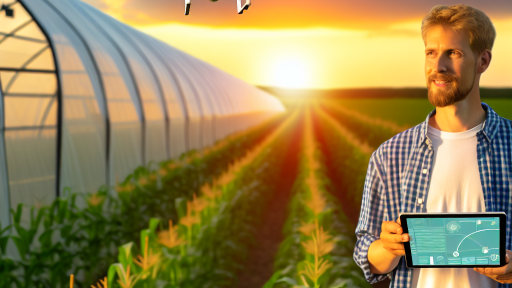Introduction to Food Safety Policies and Their Importance in Sustainable Farming
Food safety policies play a crucial role in sustainable farming.
These policies protect consumers from foodborne illnesses.
Moreover, they ensure a healthy supply chain for agricultural products.
Understanding food safety regulations fosters responsible farming practices.
Farmers must adhere to these regulations to maintain quality standards.
Non-compliance can lead to economic losses and reputational damage.
Benefits of Food Safety Policies
Food safety policies contribute to public health, which is paramount.
They enhance consumer trust in food products.
Additionally, these regulations encourage better farming practices.
By following food safety policies, farmers can improve their market access.
Key Components of Food Safety Policies
Food safety policies include various essential elements.
These elements encompass hygiene practices and proper handling procedures.
Furthermore, they establish guidelines for pesticide usage.
- Regular inspections ensure compliance with these guidelines.
- Traceability systems allow consumers to track food sources.
Ultimately, these components work together to ensure food safety.
Challenges in Implementing Food Safety Policies
Despite their importance, challenges exist in implementing these policies.
Transform Your Agribusiness
Unlock your farm's potential with expert advice tailored to your needs. Get actionable steps that drive real results.
Get StartedMany farmers face hurdles due to a lack of resources.
Additionally, varying regulations across regions can create confusion.
Small-scale farmers, in particular, may struggle to meet compliance standards.
Education and support from local organizations can help overcome these challenges.
The Role of Technology in Food Safety
Technology increasingly enhances food safety measures in farming.
For example, digital tracking systems ensure better monitoring.
Drones and sensors help in assessing crop health efficiently.
These innovations enable farmers to make data-driven decisions.
Consequently, they enhance the overall quality and safety of food products.
Engaging Stakeholders for Better Compliance
Collaboration with various stakeholders is vital for successful implementation.
Governments, farmers, and consumers must work together.
Additionally, agricultural organizations can provide vital training resources.
This collective effort improves awareness and compliance with food safety policies.
Overview of Key Food Safety Regulations Impacting Farmers
Understanding the Regulatory Landscape
Food safety regulations play a crucial role in agriculture.
Farmers must understand these regulations to operate legally.
Non-compliance can lead to significant penalties and business losses.
Several key regulations shape the farming industry today.
Food Safety Modernization Act (FSMA)
The FSMA aims to protect public health by ensuring safe food supply.
It emphasizes prevention over reaction to food safety hazards.
Farmers need to develop and implement food safety plans.
Risk analysis is essential in this process.
Additionally, the Act requires regular inspections by the FDA.
Good Agricultural Practices (GAP)
GAP guidelines help farmers minimize food safety risks.
They focus on proper farming techniques and hygiene standards.
Showcase Your Farming Business
Publish your professional farming services profile on our blog for a one-time fee of $200 and reach a dedicated audience of farmers and agribusiness owners.
Publish Your ProfileTraining employees on these practices is paramount.
Documentation of practices can aid in compliance verification.
Regular audits can ensure adherence to these guidelines.
Local and State Regulations
In addition to federal laws, local and state regulations exist.
These regulations can vary significantly depending on the region.
Farmers must remain aware of their local requirements.
Collaboration with local health departments can provide guidance.
Staying informed can help prevent unintentional violations.
Pesticide Regulations
Farmers must adhere to pesticide regulations in their operations.
Proper use and documentation of pesticides are essential.
Many states require licenses for pesticide applicators.
Understandably, misuse can lead to legal ramifications.
Farmers should prioritize using Integrated Pest Management (IPM) strategies.
Labeling Requirements
Food labeling is a critical component of food safety.
Labels must accurately reflect product contents and origins.
This transparency helps maintain consumer trust and safety.
Failure to comply can result in recalls and loss of reputation.
Emerging Trends in Food Safety
Technological advancements impact food safety regulations.
Innovation leads to improved tracking and tracing methods.
Blockchain technology is gaining popularity in the food supply chain.
Farmers should consider adopting new technologies for enhanced compliance.
Proactive approaches can mitigate future risks and challenges.
Understanding the Role of the USDA and FDA in Food Safety
Overview of USDA and FDA Functions
The United States Department of Agriculture (USDA) and the Food and Drug Administration (FDA) play vital roles in food safety.
These agencies ensure the stability and security of the food supply in the U.S.
The USDA primarily regulates meat, poultry, and egg products.
In contrast, the FDA oversees all other food products, including dairy, seafood, and produce.
Food Safety Standards and Practices
Both agencies establish stringent food safety standards.
They develop guidelines to prevent contamination and ensure proper handling.
For instance, the USDA enforces standards for meat processing plants.
Similarly, the FDA inspects food facilities to maintain compliance with health regulations.
Crisis Management and Response
The USDA and FDA coordinate responses during food safety crises.
For example, they manage outbreaks of foodborne illness effectively.
Both agencies collaborate with state and local partners to communicate safety alerts.
Effective response strategies help minimize public health risks.
Impact of Regulations on Sustainable Farming
Food safety regulations also influence sustainable farming practices.
Sustainable farms must comply with USDA and FDA guidelines.
Compliance fosters consumer trust and marketability of sustainable products.
Moreover, understanding these policies aids farmers in enhancing food safety measures.
Resources for Farmers
Numerous resources are available to assist farmers with food safety compliance.
- USDA offers educational materials and training programs.
- FDA provides guidance documents specific to food safety practices.
- Local agricultural extension offices offer tailored assistance.
Utilizing these resources can help farmers navigate complex regulations.
Showcase Your Farming Business
Publish your professional farming services profile on our blog for a one-time fee of $200 and reach a dedicated audience of farmers and agribusiness owners.
Publish Your ProfileUltimately, compliance supports both food safety and sustainable agriculture.
You Might Also Like: Benefits Of Conservation Programs For Sustainable Farming
Best Practices for Complying with Food Safety Standards on Farms
Understanding Food Safety Regulations
Food safety regulations aim to protect consumers and ensure food quality.
Familiarize yourself with local and federal guidelines.
Keep updated with changes in regulations to stay compliant.
Consult resources like the USDA and FDA for detailed information.
Implementing Good Agricultural Practices
Good Agricultural Practices (GAP) focus on minimizing risks.
Establish protocols for handling and storing produce safely.
Regularly train employees on hygiene and sanitation protocols.
Frequent audits can help identify and rectify potential issues.
Maintaining Cleanliness on the Farm
Regular cleaning of tools and equipment reduces contamination risks.
Keep storage areas organized and pest-free at all times.
Establish designated zones for handling different types of produce.
Use color-coded tools to prevent cross-contamination effectively.
Record Keeping and Documentation
Maintain detailed records of farm activities for traceability.
Document inputs like fertilizers and pesticides used on crops.
Keep logs of all food safety training conducted for staff.
Utilize farm management software to streamline documentation.
Regular Training and Education
Provide ongoing education on food safety for all employees.
Implement training sessions that cover current guidelines and practices.
Encourage feedback from staff to improve safety protocols continuously.
Host workshops with external experts for fresh insights and skills.
Engaging with the Community
Participate in local farming communities to share knowledge.
Collaborate with other farmers to develop best practices.
Engage in public awareness campaigns around food safety.
Encourage consumers to ask about food safety measures on your farm.
You Might Also Like: Navigating Agricultural Insurance Regulations for Farmers
Implementing Traceability Systems to Enhance Food Safety
Understanding Traceability Systems
Traceability systems track food products from farm to table.
They ensure transparency and accountability throughout the supply chain.
Additionally, these systems help identify the origin of food items quickly.
As a result, traceability enhances safety and consumer trust.
Components of Effective Traceability
Numerous components contribute to a robust traceability system.
Firstly, detailed record-keeping is essential.
Farmers must document each stage of production.
Secondly, utilizing barcodes or RFID tags facilitates tracking.
These technologies streamline data collection and retrieval.
Moreover, regular audits can enhance compliance and performance.
Benefits of Traceability for Farmers
Implementing traceability systems offers numerous benefits to farmers.
It boosts consumer confidence in the safety of food products.
Furthermore, traceability helps farmers manage recalls effectively.
Showcase Your Farming Business
Publish your professional farming services profile on our blog for a one-time fee of $200 and reach a dedicated audience of farmers and agribusiness owners.
Publish Your ProfileIn emergencies, identifying affected products is crucial.
Challenges in Implementation
Despite the advantages, challenges exist in implementing traceability systems.
The cost of technology can be a significant barrier for small farmers.
Additionally, training staff on new technologies is essential.
Finally, maintaining up-to-date records requires consistent effort.
Case Studies of Success
Several farms successfully implement traceability systems.
The Green Field Organic Farm uses QR codes to share product histories.
Similarly, the Sunnybrook Dairy ensures milk quality through rigorous tracking.
Both examples demonstrate the effectiveness of open information sharing.
Future Trends in Food Traceability
The future of food safety will likely involve enhanced technologies.
Blockchain technology promises immutable records for greater transparency.
Moreover, AI-driven analytics may predict potential risks in the supply chain.
Farmers who embrace these innovations will lead the way in food safety.
You Might Also Like: The Role of Agricultural Insurance in Sustainable Farming

The Intersection of Sustainable Farming Practices and Food Safety Policies
Understanding Food Safety Policies
Food safety policies protect public health and prevent foodborne illnesses.
These regulations ensure that food produced is safe for consumption.
Compliance with food safety is vital for farmers and producers.
It involves various practices, from farm management to processing and distribution.
Linking Sustainable Practices to Food Safety
Sustainable farming practices promote healthier ecosystems.
Ultimately, this leads to safer food products for consumers.
For example, crop rotation helps enhance soil health.
Healthy soil results in better crop yields and nutrition.
Thus, sustainable practices indirectly support food safety objectives.
Challenges in Compliance
Farmers often face challenges in meeting food safety standards.
Balancing sustainable practices with regulatory requirements can be difficult.
Inconsistent guidelines across different regions add to this challenge.
Moreover, economic pressures can prioritize short-term gains over safety.
Strategies for Integration
Integrating sustainable practices within food safety frameworks is essential.
Farmers can adopt integrated pest management to reduce chemical use.
This approach minimizes risks and enhances food safety.
Training programs help educate farmers on best practices and compliance.
The Role of Technology
Technology plays a significant role in modern sustainable farming.
Precision agriculture increases efficiency and reduces waste.
This method improves both environmental impact and food safety.
Data collection tools assist farmers in tracking and monitoring safety standards.
Case Studies of Success
Successful examples highlight the benefits of combining both practices.
For instance, GreenField Farms implemented eco-friendly methods.
They achieved higher yields while adhering to strict safety regulations.
This resulted in a reputation for quality and safety in their products.
Future Directions in Policy Development
Future policies must promote sustainable practices while ensuring food safety.
Showcase Your Farming Business
Publish your professional farming services profile on our blog for a one-time fee of $200 and reach a dedicated audience of farmers and agribusiness owners.
Publish Your ProfileStakeholders should collaborate to create cohesive guidelines.
Innovations in farming will also drive policy reform.
Ultimately, aligning both objectives benefits everyone involved in agriculture.
Explore Further: Understanding Agricultural Policies to Secure R&D Funding for Farmers
Challenges Farmers Face in Meeting Food Safety Standards
Understanding Regulatory Requirements
Farmers often struggle to understand complex food safety regulations.
Each regulation can differ significantly by region and crop type.
Consequently, farmers must stay informed about changing policies.
This ongoing learning can be time-consuming and overwhelming.
Implementing Best Practices
Many farms lack the resources to implement effective safety practices.
Training staff in food safety protocols can be expensive.
Moreover, maintaining consistent practices requires constant vigilance.
Farmers often juggle multiple responsibilities, making this difficult.
Accessing Resources
Access to reliable information and resources is a major hurdle.
Many farmers operate in rural areas with limited support services.
This lack of access can lead to uninformed decisions regarding safety compliance.
Furthermore, online resources may not be tailored to local needs.
Cost of Compliance
Compliance with food safety standards can strain small farmers financially.
Expenses associated with testing, training, and equipment can add up.
Additionally, the cost of lost crops due to compliance failures is significant.
As a result, many farmers may prioritize production over safety measures.
Managing Supply Chain Risks
Food supply chains introduce numerous safety challenges for farmers.
Each link in the chain must adhere to safety protocols.
Consequently, farmers often face hurdles in ensuring vendor compliance.
Any lapse could jeopardize their operation and reputation.
Staying Ahead of Inspections
Regular inspections can be daunting for many farmers.
Anticipating and preparing for inspections requires significant preparation.
Farmers often worry about unexpected visits from regulatory bodies.
This stress can distract from daily farm operations and productivity.
Future Trends in Food Safety Regulations for Sustainable Agriculture
Integration of Technology
Technology will play a crucial role in future food safety regulations.
Farmers will adopt advanced data analytics for monitoring food safety.
This will enhance traceability across the supply chain.
Additionally, blockchain technology will ensure transparent record-keeping.
Consequently, consumers can trust the origins of their food products.
Emphasis on Preventive Controls
Regulations will increasingly focus on preventive measures in farming.
This shift aims to minimize risks before they manifest.
Farmers will need to implement hazard analysis systems.
These systems will help identify potential food safety hazards.
As a result, proactive management strategies will become essential.
Enhanced Collaboration with Industry Stakeholders
Collaboration among farmers, regulators, and consumers will increase.
Such partnerships will foster a shared commitment to food safety.
Showcase Your Farming Business
Publish your professional farming services profile on our blog for a one-time fee of $200 and reach a dedicated audience of farmers and agribusiness owners.
Publish Your ProfileWorkshops and training sessions will be critical for knowledge sharing.
These initiatives will promote adherence to safety standards.
Furthermore, industry stakeholders will advocate for better practices.
Stricter Regulatory Standards
Future food safety regulations will likely become more stringent.
Farmers must comply with these evolving safety requirements.
Non-compliance may result in substantial penalties or loss of certification.
Therefore, staying informed on regulatory updates will be vital.
Agricultural organizations will provide resources to assist farmers.
Focus on Sustainability and Food Security
Policies will integrate sustainability into food safety standards.
Farmers will need to demonstrate sustainable practices.
Such practices will include soil health and crop rotation strategies.
Moreover, the connection between food safety and climate change will be highlighted.
Ultimately, sustainable approaches will enhance overall food security.
Additional Resources
Navigating the environmental, economic and social impacts of …




